
A mishmash, or exciting diversity?
On the 2021 Spring Exhibition of the Estonian Artists’ Association at Tallinn Art Hall
Maria Helen Känd
Tallinn Art Hall’s Spring Exhibition of the Estonian Artists’ Association is a traditional format in which a selection of works from a total of 359 submitted applications has been exhibited. This year there are works by artists ranging between the ages of 23 and 93 – from the enchanting grand dame of Estonia’s abstract painting, Lola Liivat, to the young and bold Brenda Purtsak, whose canvases depict broken tissues and internal organs. Spring is a time for growth, and it is welcoming to see that the jury has heard the voices of many young artists.
Work by Lola Liivat. Photo: Stanislav Stepaško, Tallinna Kunstihoone
Work by Brenda Purtsak. Photo: Stanislav Stepaško, Tallinna Kunstihoone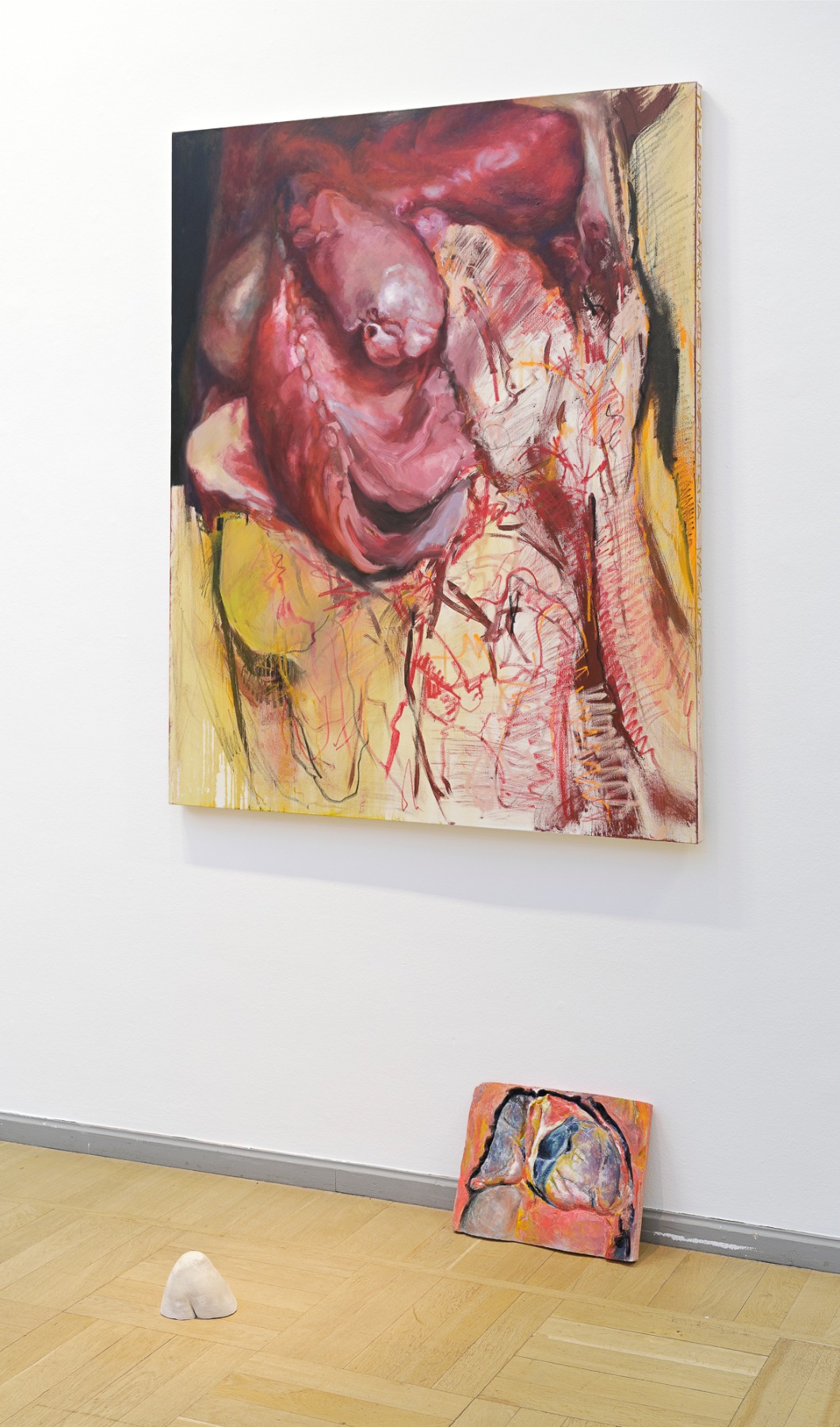
Although over the years the Spring Exhibitions have become more strongly designed and thematically curated wholes, the feat of showing more than 55 artists and their integration into the current spatial conditions of Tallinn Art Hall has certainly posed a challenge to curators. Applying this concept has the inevitable outcome of arriving at a varied mixture of styles, signatures, and positions. A visitor who prefers minimalism could consider the exhibition to be too much of a mishmash, while someone coming at it from a different angle may see it as excitingly diverse.
Bridges between works have been created, for example, through a harmony of color play, such as in the surprising dialogue between Mihkel Maripuu’s explosive internet- and street-art-inspired painting and Ulvi Haagensen’s homely handicraft installation.
Works by Mihkel Maripuu and Ulvi Haagensen. Photo: Paul Kuimet, Tallinna Kunstihoone
Connections can also be found thematically, for example, in the futuristic city visions of Britta Benno and Kadri Toome. The exhibition could be compared to a buffet at which you try a little here and there, and even if sometimes salty and sweet come together, it doesn’t taste hideous if you discover something good. This is how it can be at the Spring Exhibition, but one thing you can be sure of is finding undiscovered talent among well-known artists. The following is a list of highlights you can see in both the main and satellite exhibitions of this spring’s show.
Work by Britta Benno. Photo: Stanislav Stepaško, Tallinna Kunstihoone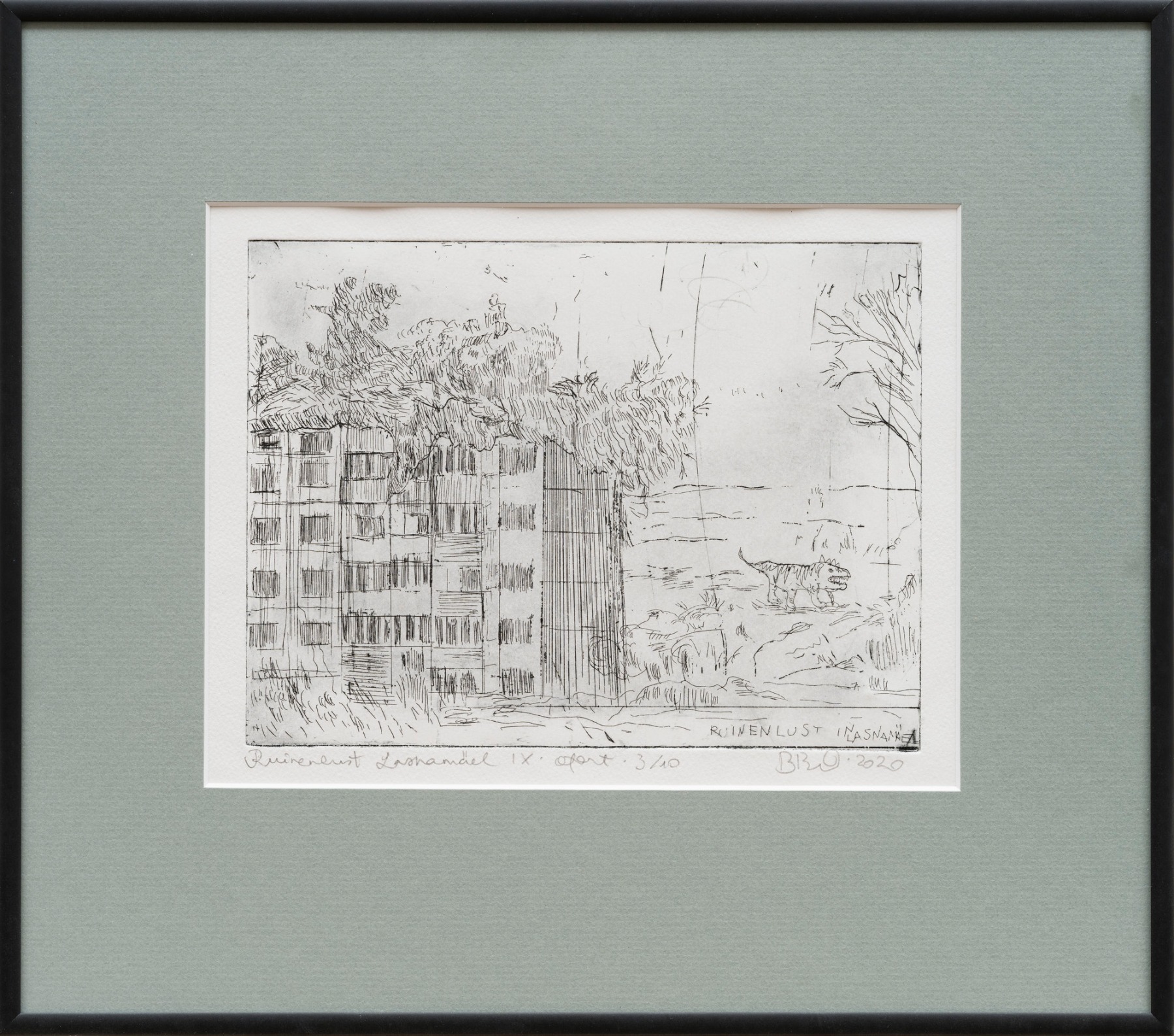
Work by Kadri Toom. Photo: Stanislav Stepaško, Tallinna Kunstihoone
Inevitable nature and human submission
Arriving at the Main Hall, an allegorical trio of life-death-rebirth greets you. The stone sculpture hanging from the ceiling – by Sarah Nõmm, who just won the Young Sculptor Award – has been put in conversation with Jüri Arrak’s legendary mythological world and Rein Mägar’s watercolor depicting childbirth. Significant themes have been set as an opening: waiting, natural inevitability, and human submission to it.
Work by Sarah Nõmm. Photo: Stanislav Stepaško, Tallinna Kunstihoone
Nõmm, who deserves to be accentuated from the trio, creates a symbolically powerful portrait of the springs of both 2020 and 2021, which pushed the boundaries of human existence and turned our lives upside down. However, the symbolism in the work does not come across too directly and plainly because the form of the work prevails. The boulder hanging by a firm rope manifests the material, while delicate details, such as pieces of hair, evoke poetry. It seems as if something personal and universal meet in this sculpture.
Sten Saarits. “Ten-Kilometer-High Dreams”. Photo: Stanislav Stepaško, Tallinna Kunstihoone
Katariin Mudist. “Fine, I’m thanks!”. Photo: Stanislav Stepaško, Tallinna Kunstihoone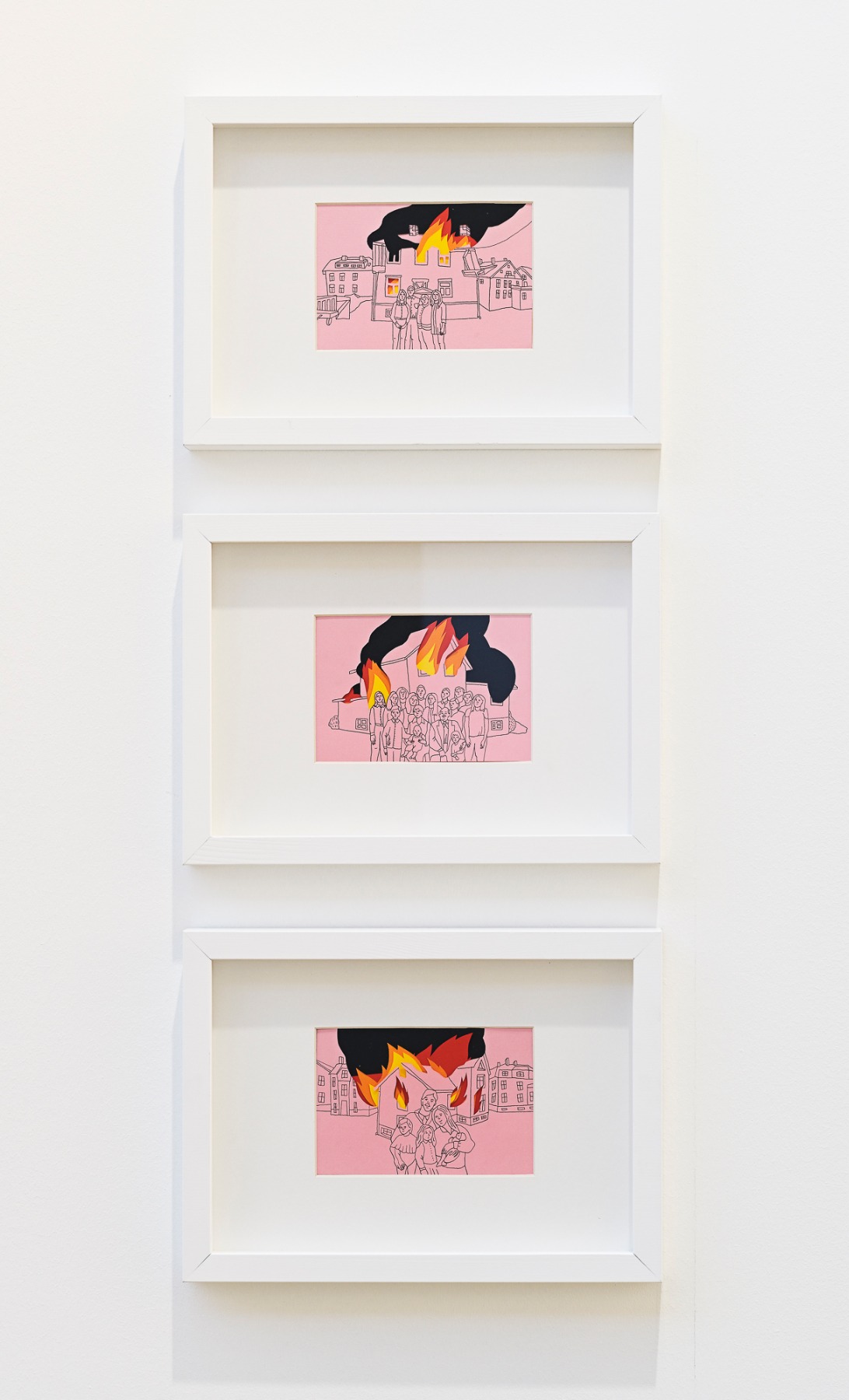
Sten Saarits’ slowly arriving plane projection “Ten-Kilometer-High Dreams”, and the opposite pairing of a series of family portraits done in papercuts, “Fine, I’m thanks!” by Katariin Mudist, give a somber but accurate comment on the past year. Saarits’ dreams of traveling and change are concentrated in a pleasantly minimalist projection in which the umbilical cord of dreams is cut when the plane does not land. Displayed as a shadow on a white background, it emphasizes anonymity, vagueness, and the unattainability of the abstract mental image that travelling has now become. Mudist’s papercuts – depicting smiling families in front of burning houses – bring out the edges of enforced lockdown with black humor. These family photos can be viewed as a critique of our denial of the looming climate catastrophe: our home, Mother Earth, is on fire, but we’re choosing which curtains we should buy. The images can also be linked with social troubles that emerged during the pandemic, e.g., families that from the outset seemed to be living perfect lives turned out to have problems finding balance at home because tensions couldn’t be easily vented and you couldn’t hide behind a mask like you could when being outside of your house.
Photo: Paul Kuimet, Tallinna Kunstihoone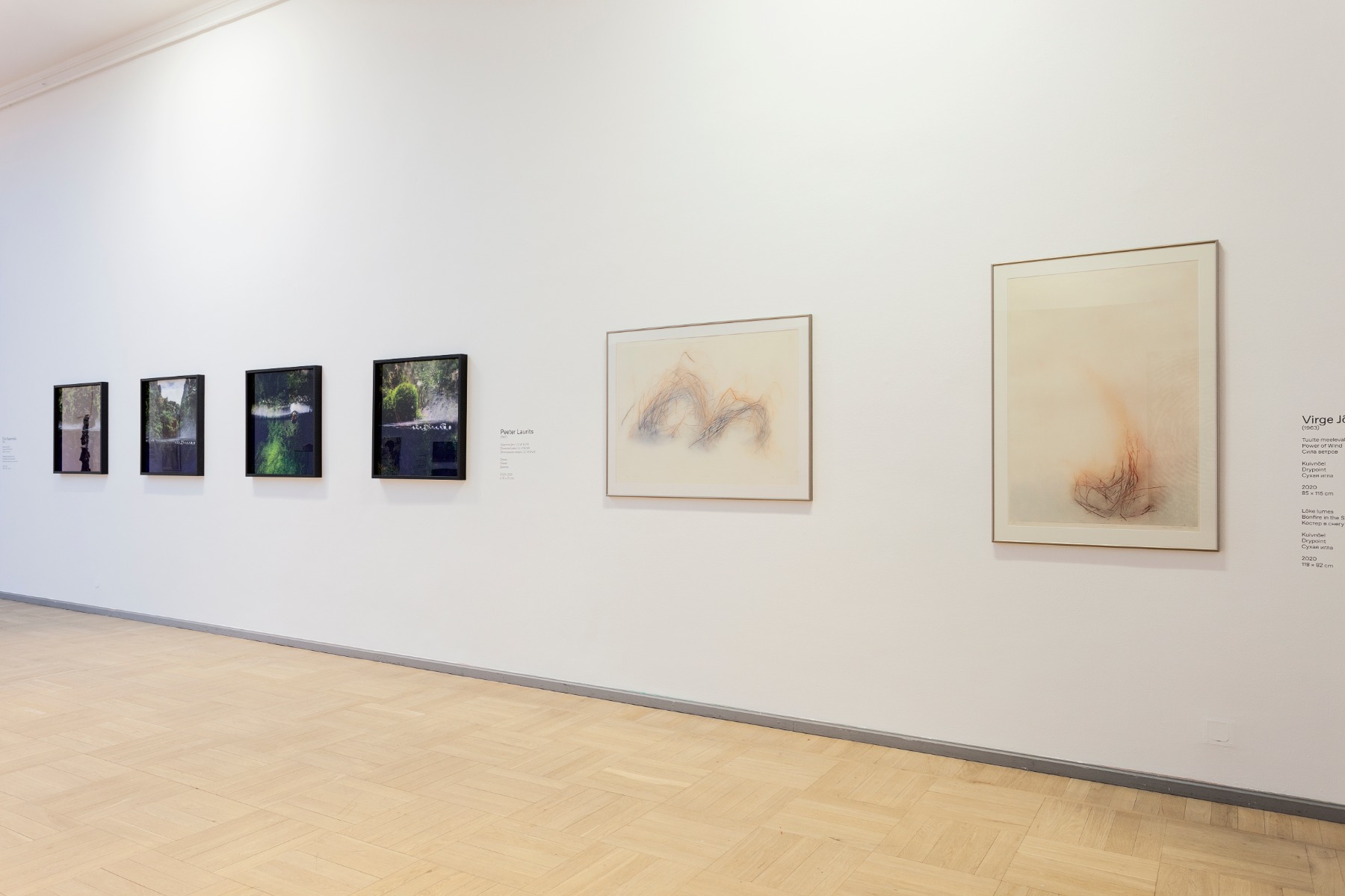
In the first hall, nature imagery stands out. In some cases the works lead the viewer fantastically close and unrealistically deep into natural environments, be it the photographs by Peeter Laurits, or Jaanika Arum’s installation that invites visitors to participate and therefore makes the experience almost too direct. Eloquence can be seen in the more abstract approaches to the primordial forces around us, such as in Virge Jõekalda’s dry-needle prints, which with their red-orange etching on a white soft background cuts into the viewer with a decidedly delicate touch.
Ove Maidla. “Flower Seller with Extremely Cold Nerve”. Photo: Stanislav Stepaško, Tallinna Kunstihoone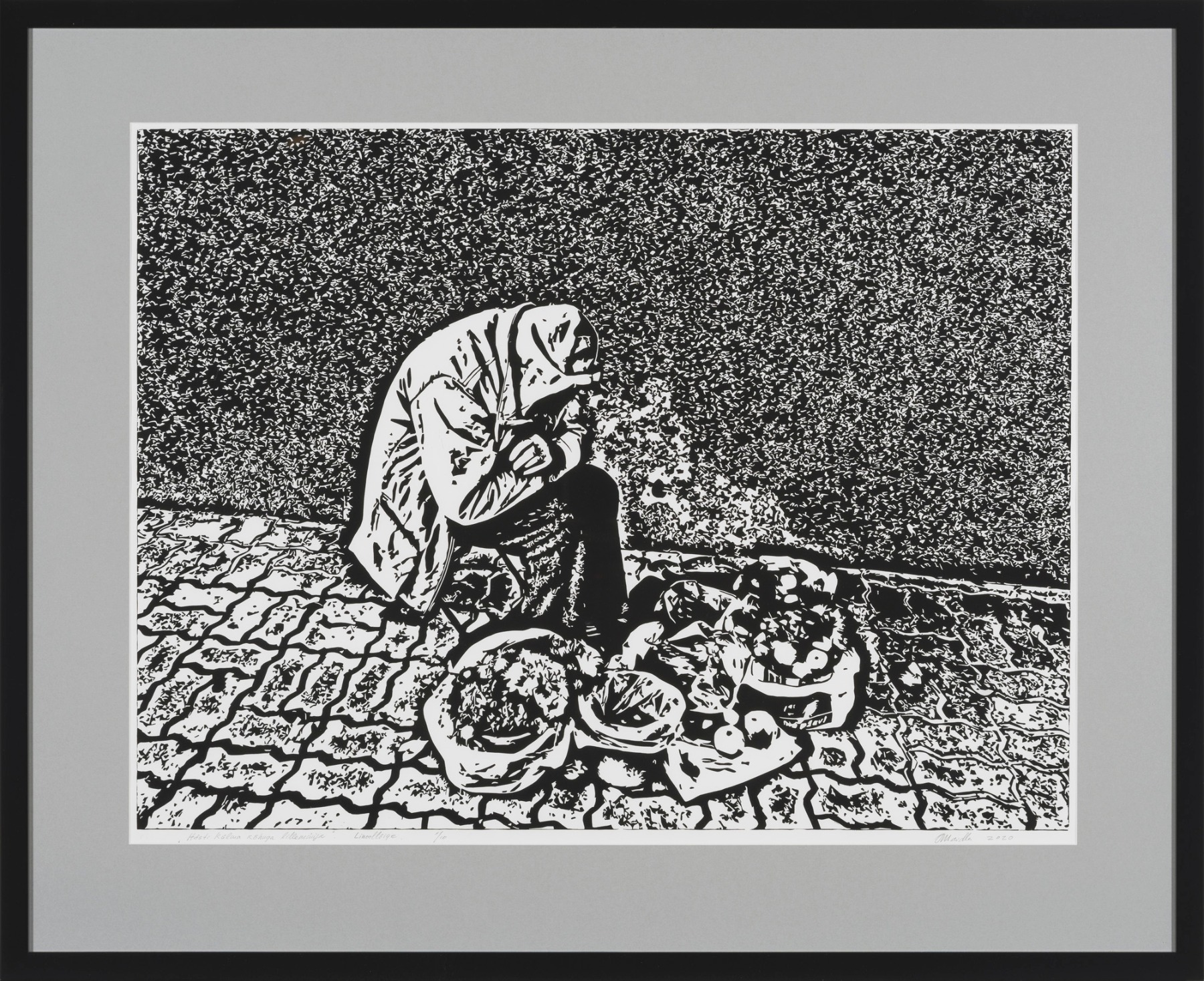
The linocut “Flower Seller with Extremely Cold Nerve” by Ove Maidla, located on the diagonal from Jõekalda’s piece, again makes a socially critical remark. Back to back with Maidla, Evi Tihemets-Viires’ collage print “Stop for a Moment!” exudes a similarly strong but more personal emotion.
Evi Tihemets-Viires. “Stop for a Moment!” Photo: Paul Kuimet, Tallinna Kunstihoone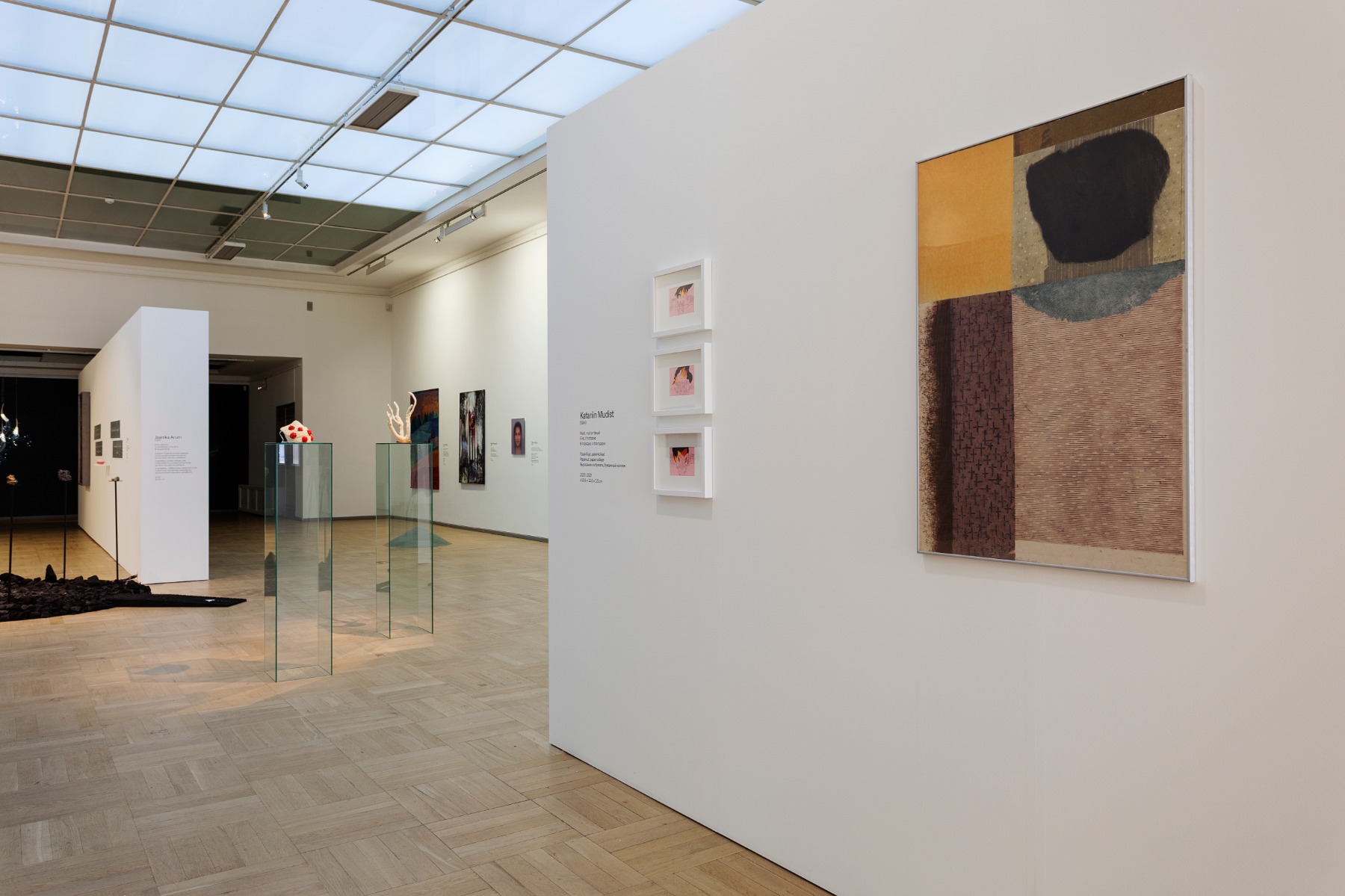
A more conceptual approach to spring
Both spatially and conceptually, Evi Pärn’s “Corridor of Power” has found its most natural location. The work architecturally binds the Soviet-era extension of Tallinn Art Hall to the original building. Pärn’s installation critically approaches Kumu Art Museum's permanent exhibition of Estonian art of the 20th century, specifically targeting the museum’s informational boards that describe only in Estonian and English the historical contextualization of the works on display. Pärn has lined the corridor with new informational boards that have been supplemented with Russian translations of the texts, and conversely, the Estonian and English versions have been blurred to the point of being unintelligible. The work highlights the exclusion of the Russian-speaking population in the art history of Estonia by making the visitor experience the exhibit as Russian-speaking visitors must when the museum is in its standard configuration.
Evi Pärn. “Corridor of Power”. Photo: Stanislav Stepaško, Tallinna Kunstihoone
Even new constructs of meaning appear in the dialogue between Pärn’s work and the language-based paintings of Mall Paris – proclaiming “Visible Invisible” and “Light of the Century”, they add even more clarity to the irony of the situation.
Mihkel Ilus. “Commodity Painting. Pickett”. Photo: Paul Kuimet, Tallinna Kunstihoone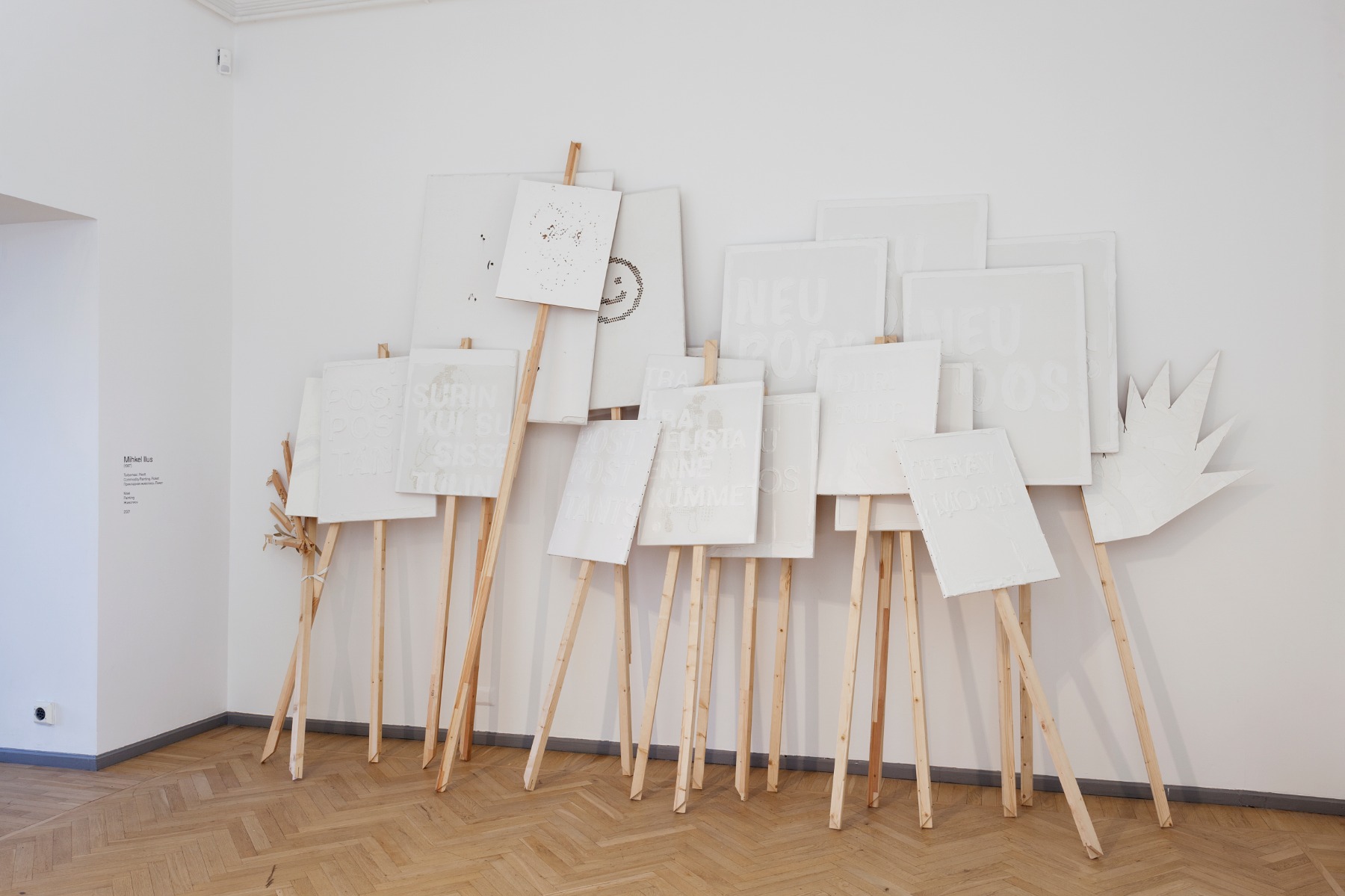
Mihkel Ilus’ conceptual installation “Commodity Painting. Pickett” functions well in the company of the two above-mentioned artists. Ilus, who mostly deals with the deconstruction and reconstruction of painting as an artistic medium, has again given the canvas a new function – that of a demonstration plaque. For those who have followed the political scene of recent years, the work appears to act as a grotesque retrospective of the gatherings of different sound chamber groups at Freedom Square in Tallinn. The quotes displayed on the canvases are not really related and sound arbitrary and absurd, thereby indicating the true emptiness of the various phrases and slogans that have recently been bandied about.
Liisi Eelmaa. “Abracadabra”. Photo: Paul Kuimet, Tallinna Kunstihoone
Conceptually playing with spatial parameters, Liisi Eelmaa, who mainly works as a theater artist, has created the coda to the main exhibition in the main rooms of Tallinn Art Hall. In her colorful installation “Abracadabra”, Eelmaa throws the content of a two-dimensional image distortedly back into space. By turning it inside out, the exhibition returns to the beginning, back to the main motif.
More air in satellite shows
In the satellite exhibitions “From Head to Toe” (Art Hall Gallery) and “Outside / In” (City Gallery) there is more air and more coherence in the respective spaces, which makes the subjects easier to grasp.
Works by Solveig Lill. Photo: Paul Kuimet, Tallinna Kunstihoone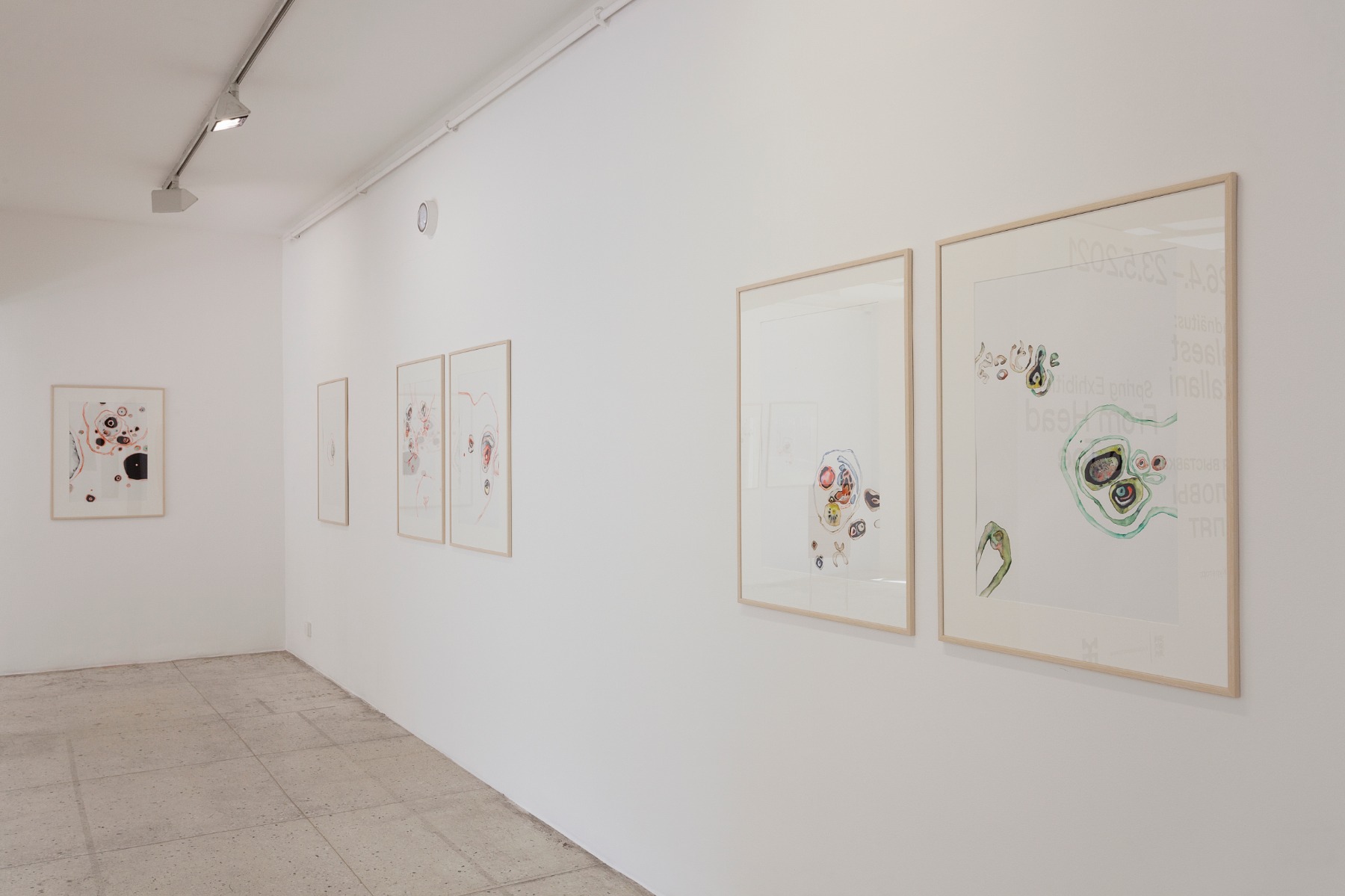
“From Head to Toe” (curated by Siim Preiman) introduces six young female artists’ interpretations of physical and sociological bodily experiences. For example, Solveig Lill’s alluring watercolors present enlarged cell membranes, but in a much softer and more playful way than can usually be seen under a clinical microscope. Seeing them creates a kind of strange pleasure and tenderness about bodily functions that play a vital role but are otherwise invisible.
Work by Cloe Jancis. Photo: Paul Kuimet, Tallinna Kunstihoone
Cloe Jancis also experiments with bodily layers in a performative video in which she demonstrates covering with borrowed plumes the bodily features that we would not like to be visible to others. Jancis’ distorted face reminds us that, ever since the appearance of the Kardashian family reality show, in terms of body image, the artificial has risen next to the natural. Kelli Gedvil’s “Not Like Other Girls”, located next to Jancis’ piece, is an eye-catching and aesthetically captivating installation, but its concept remains confusing without an accompanying text.
Kelli Gedvil. “Not Like Other Girls”. Photo: Paul Kuimet, Tallinna Kunstihoone
“Outside/ In” is the most political part of the whole spring program and clearly expresses the curatorial position of Corina Apostol. Apostol will be curating the Estonian pavilion at the upcoming Venice Biennale, which is focusing on minority issues and the history of inequality and its expressions in the contemporary world.
Work by Aksel Haagensen. Photo: Paul Kuimet, Tallinna Kunstihoone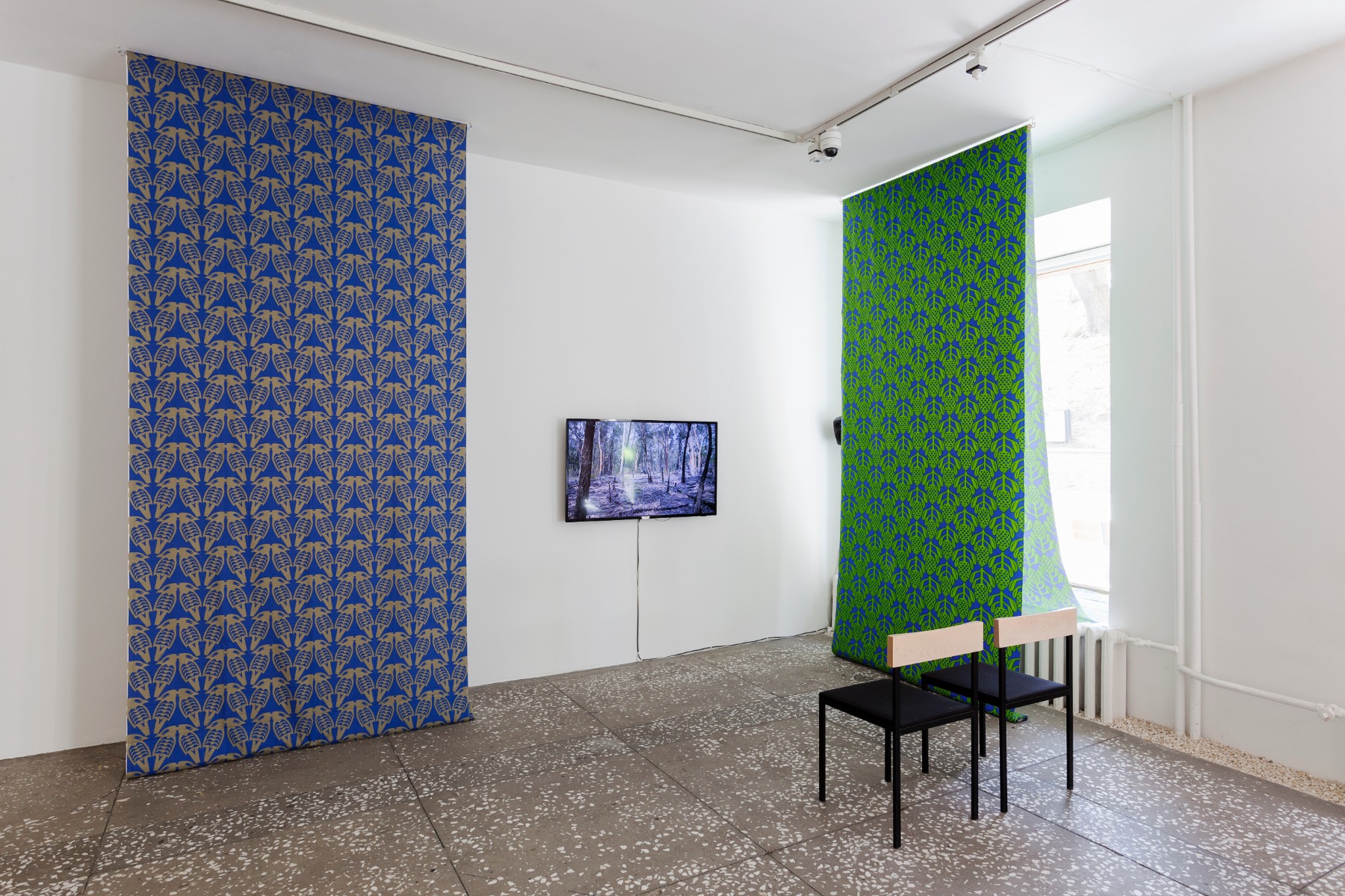
In his short film, Aksel Haagensen (Australian-born but of Estonian descent, and now lives in Tallinn) makes a visit back to Australia to his grandmother, a WWII refugee. Although the second part of the work – textiles designed by the artist’s grandmother that descend from the ceiling to the windows – lose their effectiveness in the low-ceilinged space, Haagensen’s video presents an important narrative of Baltic boat refugees. The personal story is conveyed in a quiet and not too pathetic way – holding the memory without twisting it.
“The First”. Photo: Paul Kuimet, Tallinna Kunstihoone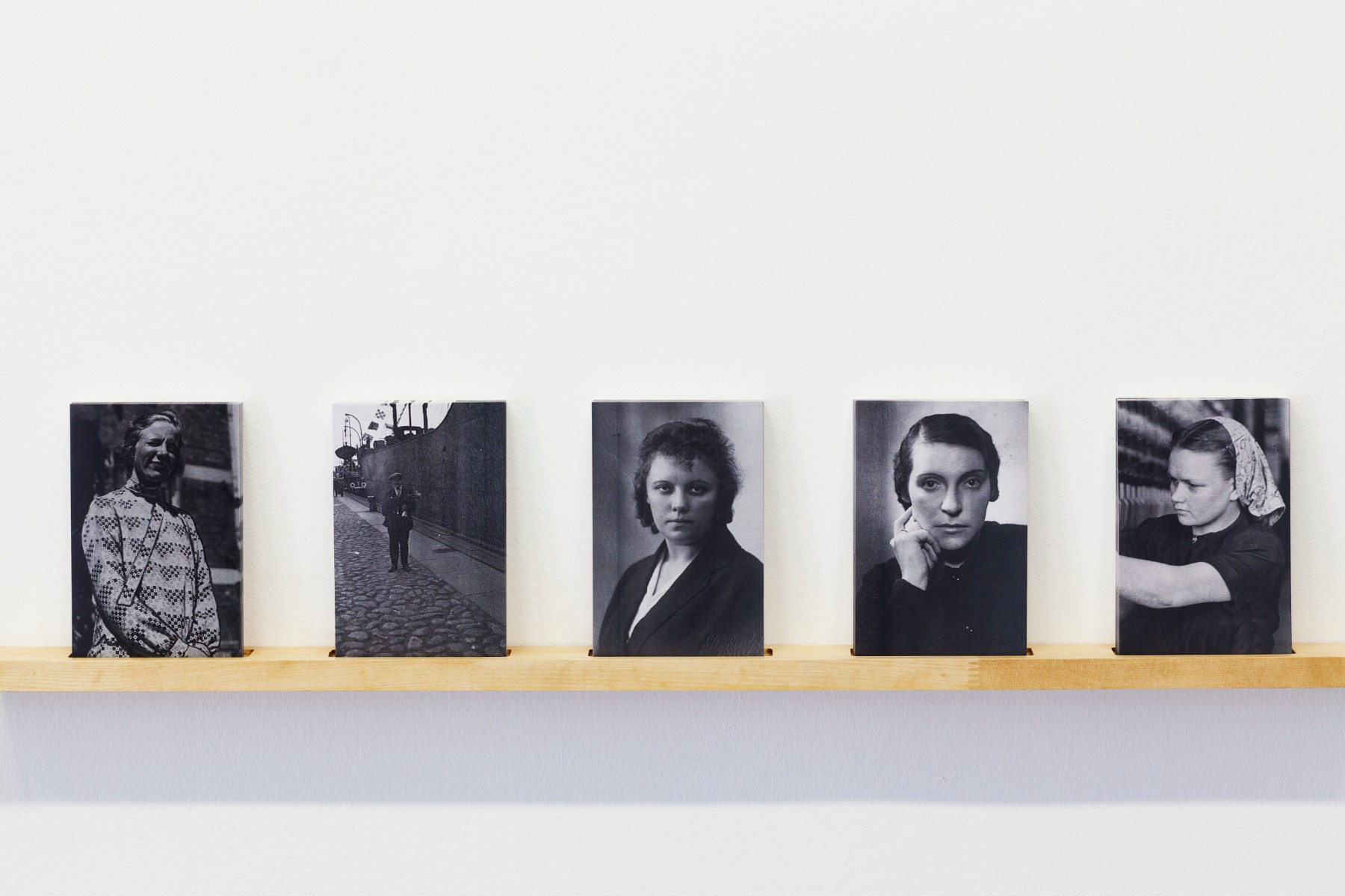
A contrasting but essentially well-functioning dialog can be found between the installations “The First” and “Feminist Utopias”. One consists of black and white postcards featuring Estonian women pioneers, whereas the other is a series of colorful abstract drawings. If the first refers to historical reality, then the second refers to possibilities and the lack of freedom, spontaneity and play, which are sometimes scarce in a gray post-Soviet society.
“Feminist Utopias”. Photo: Paul Kuimet, Tallinna Kunstihoone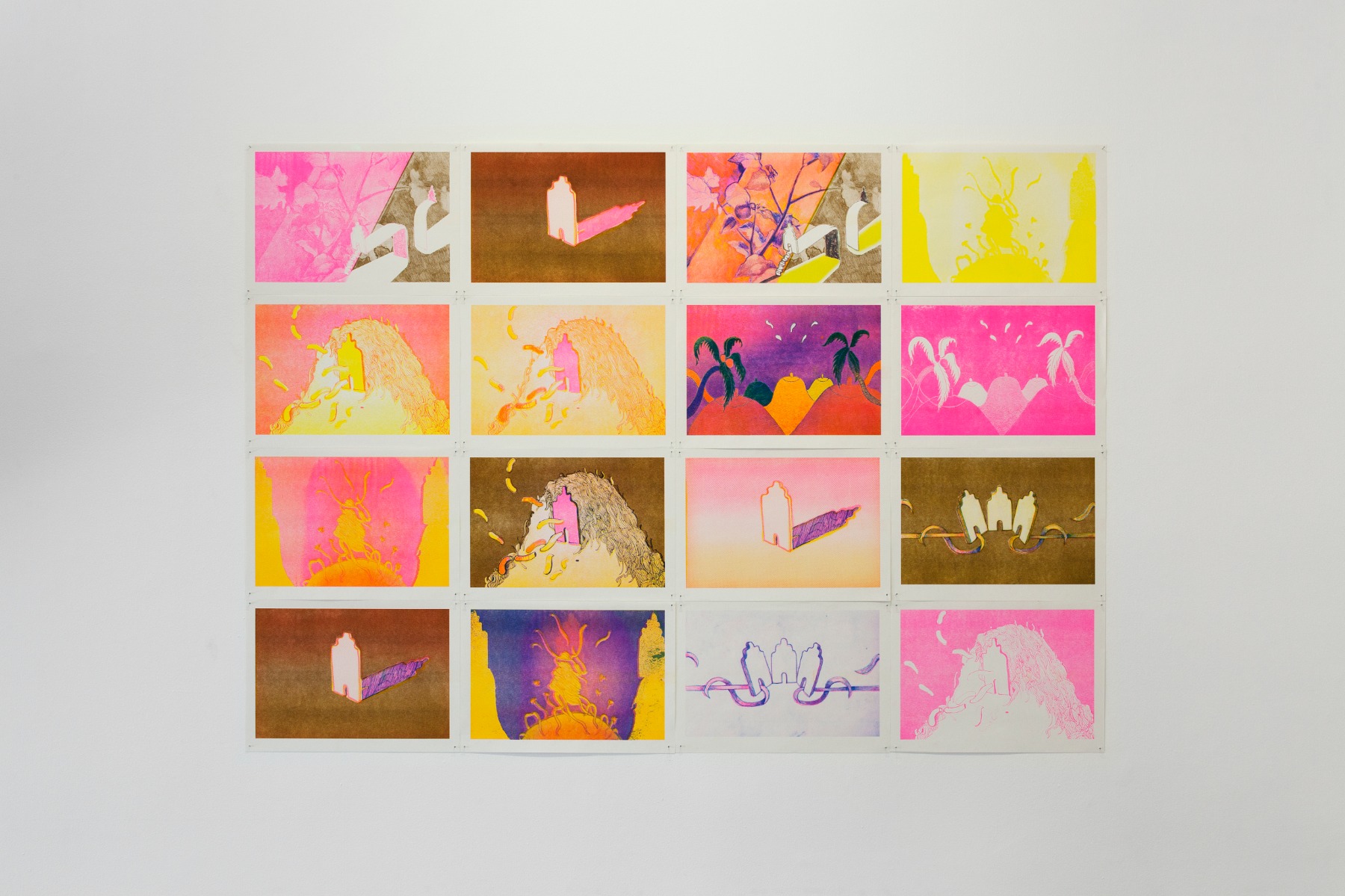
Future springs
This year’s Spring Exhibition doesn’t necessarily offer an overview or representative cross-section of the Estonian art scene. Instead, it provides pieces through which to arrive at a personal and broader understanding of the Estonian art scene. This is because, firstly, many successful local artists do not participate and the number of artists is limited. Secondly, the strength of the artists can best be witnessed in solo exhibitions or smaller group shows, which are organized at a very good level throughout the year at Tallinn Art Hall, but which are visited less compared to the popular Spring Exhibition.
The number of candidates submitting for this year’s Spring Exhibition was the highest so far. Although the Spring Exhibition has and will become more popular in terms of the number of participants, I hope that it will also become more elliptical. I wish the jury the courage to further reduce the number of participating artists – at least while we await the renovation of Tallinn Art Hall (opened in 1934), which is planned to take place in 2022.